‘A higher tribunal than the House of Lords’
Published in 20th-century / Contemporary History, Features, Issue 4 (July/August 2018), Volume 26Why did two branches of north Kerry’s McEllistrim family take opposite sides in a bitter dispute between private creameries and the co-operative movement?
By Eoin McLaughlin and Paul Sharp
One of the perennial questions in Ireland’s economic history is why, despite her proximity to the dominant British market and her historical advantages, she lost her position as the world’s largest exporter of butter at the end of the nineteenth century. The heartland of Munster, the renowned Golden Vale or Golden Vein, consisted of rolling pastureland that was exceedingly good for dairy farming and included the traditional centre of the butter trade, Cork, with its famous butter market (now the Cork Butter Museum).
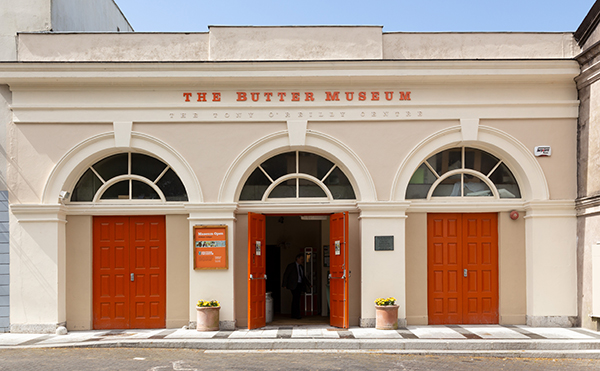
Above: Cork Butter Museum today—originally the butter market. But why did Ireland lose her position as the world’s largest exporter of butter at the end of the nineteenth century? (Cork Butter Museum)
The co-operative model
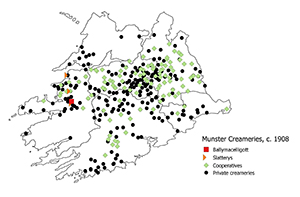
Above: There was a large presence of both co-operatives and private creameries contesting the Munster butter market. Richard McEllistrim had been a member of the Ballymacelligott co-op but started to send his milk to Slattery’s.
In the 1910s two branches of the north Kerry McEllistrim family took opposite sides in bitter commercial disputes involving private creameries, such as Cleeve’s and Slattery’s, and the co-operative movement, led by the IAOS. Richard ‘Dick’ McEllistrim, with the help of Slattery’s, sued the Ballymacelligott co-op and had his day in court, winning his case in 1919. Nevertheless, the Ballymacelligott creamery and Thomas ‘Tommy’ McEllistrim (Richard’s nephew), of Volunteer fame, won out in the end, with the ‘nationalisation’ of the creamery sector along co-operative lines in the 1920s and the establishment of a McEllistrim political dynasty in north Kerry. The McEllistrim family feud developed into a high-profile national court case and led to the legal foundations of the modern Irish dairy industry.
House of Lords 1919 judgement
The IAOS and co-operatives were involved in long legal battles in the 1910s whereby the validity of binding milk supply contracts was tested in court. These court cases culminated in the judgement on the case of McEllistrim v. Ballymacelligott Co-operative Agricultural & Dairy Society Ltd on 24 March 1919. In the initial appeal, McEllistrim, who had been a member of the co-op since 1903, ‘sued on his own behalf and on the behalf of other members’ because new rules introduced by the co-op in 1915 effectively meant that members could only supply milk to the co-op ‘for the whole period of their lives’, and he wanted a judgement on whether these new rules were an ‘unreasonable restraint of trade’ (Irish Times, 20 February 1918). The secretary of the Ballymacelligott co-op, Mr Byrne, had stated that the reason for the introduction of the new rule was because the co-op was planning to set up a new auxiliary at Goralea and ‘also to prevent members being tempted away by fancy prices offered by competitors’.
With this House of Lords judgement, however, co-operation in the form that had proven so successful elsewhere was declared an illegal restraint on trade. Without binding contracts, rival creameries fought for the limited supplies of milk and were forced to pay higher prices to ensure supplies, or to accept lower standards. The failure of the ‘binding rule’, combined with a strong private commercial dairy sector that was opposed to co-operation, reinforced the already difficult conditions for dairying in Ireland owing to poor social capital. Kevin O’Rourke has demonstrated that levels of co-operation were lower in counties where there were more ‘outrages’ (i.e. crimes against persons or property) at the height of the Land War (1880–2). One particular example of this resulted directly from the notorious McEllistrim v. Ballymacelligott case.
Slattery’s destroyed by gelignite
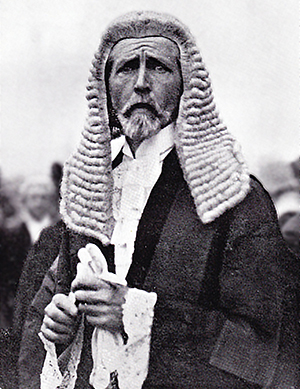
Above: Following the 1919 House of Lords judgement and the subsequent bombing of Slattery’s, there was even an attempt on the life of Serjeant Sullivan, Slattery’s legal counsel, who had also represented Richard McEllistrim (and, more famously, Roger Casement).
‘[the bombing] was done in answer to the House of Lords’ decision in the case of McEllistrim against the Ballymacelligott co-operative Creamery Society. There is a higher tribunal than the House of Lords, and that tribunal decided that Slattery’s creamery no longer exists.’
This, however, led to a further court case for compensation against the Ballymacelligott co-op by owners and suppliers of Slattery’s for damages and loss of trade. Tellingly, it was noted that ‘the matter arose out of what was purely a commercial dispute’ between Slattery’s and the co-operative creamery.
This was not the end of the story, as further attacks were made on Slattery-owned creameries within a few weeks of the House of Lords decision. There was even an attempt on the life of Serjeant Sullivan, Slattery’s legal counsel, who had also represented McEllistrim (and, more famously, Roger Casement), where it was reported that the eleven men on trial were ‘all the sons of farmers who sent their milk to the Ballymacelligott Co-operative creamery’.
Richard McEllistrim had been a prominent figure in the often-violent Land War in Kerry. In this instance, however, the violence was directed not against landlords but against the House of Lords’ overruling of the Ballymacelligott co-op’s binding rule. This illustrates how the institutional deficiencies of the co-operatives may have exacerbated the lack of social capital, thereby explaining their poor performance in Ireland at the turn of the century.
Ballymacelligott co-op burnt by Auxiliaries, November 1920
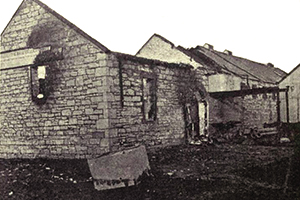
Above: Ballymacelligott Co-operative Creamery was itself attacked in November 1920, this time by Crown forces. (Report of the Labour Commission to Ireland)
This account, however, does not tally with the later recollections of Thomas McEllistrim, lieutenant of the Ballymacelligot Company in the Kerry IRA, who noted that, when ten lorries of ‘Tans and RIC’ appeared at the creamery,
‘… some members of Ballymacelligott ASU happened to be near the creamery at the time and made a dash for escape. Fire was opened on them immediately by Tans and RIC. Two men were shot dead and two wounded, while others escaped.’
This would strongly suggest an IRA link with the Ballymacelligott co-op, although this was disputed by Fr Trant and the Labour Commission.
IRA/Ballymacelligott connections
The incidents in Kerry are also notable given the connection between the Ballymacelligott co-op and the IRA—its manager was an IRA officer and later embezzled money from it. Moreover, in Kerry farmers made up 56% of the IRA’s rank and file in the period 1918–21, and IRA manoeuvres rarely began before seven in the evening ‘on account of the milking’. This connection between the IRA leaders and rank and file and the co-operative movement is important, especially as veterans of the latter would later become involved in the new Free State legislature.
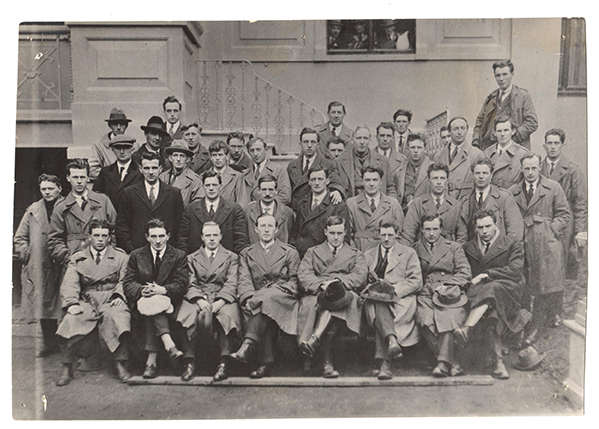
Above: Officers of the 1st Southern Division attending an IRA convention in the Mansion House, Dublin, 9 April 1922. Thomas McEllistrim, lieutenant of the Ballymacelligott Company of the IRA, is in the back row, second from the right. (Kilmainham Gaol Archives)
The irony here is, of course, that when Plunkett and his colleagues first attempted to establish co-operative creameries in the 1880s and 1890s there was nationalist hostility towards them. They were infamously told in one instance in Rathkeale, Co. Limerick, that ‘every pound of butter made in this creamery must be made on nationalist principles, or it shan’t be made at all’.
Unsurprisingly, therefore, although courts in the Irish Free State (owing to its status as a dominion) were bound to abide by the new rule forbidding binding milk supply contracts, independent Ireland soon legislated on the issue. Binding contracts were introduced as part of the 1928 Dairy Act, which made it illegal for co-operative societies to accept milk from members of other societies without the written permission of the Department of Agriculture. Furthermore, dairying was made exclusively co-operative under the IAOS through the purchase of Cleeve’s and the Newmarket Dairy Company (for a combined total of £365,000), and other minor proprietary concerns, thus obviating the problem. The establishment of the Dairy Disposal Company meant a take-over of both private creameries and insolvent co-operatives and the greater co-operativisation of the Irish dairy industry. The institutional problem was fixed, although the damage wrought by the legal struggle on social capital in the countryside would take longer to heal.
Eoin McLaughlin lectures in geography at the University of St Andrews; Paul Sharp is Professor of Business and Economics at the University of Southern Denmark.
FURTHER READING
I. Henriksen, E. McLaughlin & P. Sharp, ‘Contracts and cooperation: the relative failure of the Irish dairy industry in the late nineteenth century reconsidered’, European Review of Economic History (2015).
S. Joy, The IRA in Kerry, 1916–1921 (Cork, 2005).
K. O’Rourke, ‘Culture, conflict and cooperation: Irish dairying before the Great War’, Economic Journal 117 (2007).
H. Plunkett, Ireland in the new century with an epilogue in answer to some critics (London, 1905).
















